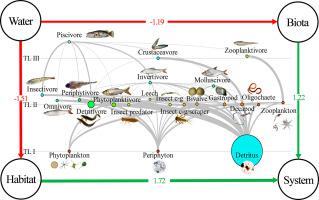Science of the Total Environment ( IF 8.2 ) Pub Date : 2021-06-24 , DOI: 10.1016/j.scitotenv.2021.148673 Sai Wang , Tuan-Tuan Wang , Hsing-Juh Lin , Simon D. Stewart , Gong Cheng , Wei Li , Feng-Juan Yang , Wen-Da Huang , Zhong-Bing Chen , Song-Guang Xie

|
Tropical and subtropical rivers are being subjected to multiple stressors from human disturbance (e.g., water pollution and habitat degradation). Understanding the relationship between environmental conditions and the river ecosystem is important for improving river management. We built 14 Ecopath models composed of 28 functional groups (trophic levels [TLs] of 1.0–3.8) along a subtropical urban river to explore the influence of environmental changes on system attributes. From headwaters to downstream, the model outputs showed that the transfer efficiency (TE), energy flow parameters, and ecosystem theory indices exhibited significant (P < 0.05) differences across a longitudinal gradient of disturbance, indicating heterogeneous attributes of local river segments. The high TE values of TLs I, II, and III separated the upper, middle, and lower reaches, respectively, which could be attributed to the shift in dominant consumption flows from upstream ‘periphyton – aquatic insects – insectivorous fish’ to midstream ‘detritus – shrimp – crustaceavorous fish’ and to downstream ‘phytoplankton – filter-feeding invertebrates/fish’. Structural equation modelling was used to test the causal relationships among environmental variables and demonstrated that abiotic factors directly influenced biomass composition and indirectly influenced trophic networks. Water quality, including dissolved oxygen and flow velocity; habitat characteristics, such as riffles, cobble-gravel substrate, and seasonal floodplain; and biological indicators, including the relative contributions (%) of decapods, insectivorous fish, and insect scrapers to biomass composition, had significant (P < 0.05) positive impacts on system maturity (evaluated by omnivory, connectance, and cycling indices). In the future, it will be possible to evaluate the health of river ecosystems by monitoring representative environmental factors, which could be a cost-effective approach to system-level improvement.
中文翻译:

环境因素对华南亚热带城市河流食物网结构、能量流动和系统属性的影响
热带和亚热带河流正受到人为干扰(例如水污染和栖息地退化)的多重压力。了解环境条件与河流生态系统之间的关系对于改善河流管理很重要。我们沿着亚热带城市河流建立了 14 个由 28 个功能组(营养水平 [TL] 为 1.0-3.8)组成的生态路径模型,以探索环境变化对系统属性的影响。从源头到下游,模型输出表明传输效率(TE)、能量流参数和生态系统理论指数表现出显着(P< 0.05) 扰动纵向梯度的差异,表明当地河段的异质属性。TLs I、II 和 III 的高 TE 值分别将上游、中游和下游分开,这可能归因于主要消费流从上游“附生生物-水生昆虫-食虫鱼类”转向中游“碎屑” – 虾 – 甲壳类鱼类”和下游的“浮游植物 – 滤食性无脊椎动物/鱼类”。结构方程模型用于测试环境变量之间的因果关系,并证明非生物因素直接影响生物量组成并间接影响营养网络。水质,包括溶解氧和流速;栖息地特征,如浅滩、鹅卵石基质、和季节性洪泛区;和生物指标,包括十足目动物、食虫鱼类和昆虫刮刀对生物量组成的相对贡献(%),具有显着的(P < 0.05) 对系统成熟度的积极影响(通过杂食性、连接性和循环指数评估)。未来,可以通过监测代表性环境因素来评估河流生态系统的健康状况,这可能是系统级改进的一种具有成本效益的方法。











































 京公网安备 11010802027423号
京公网安备 11010802027423号